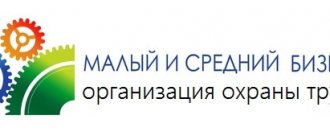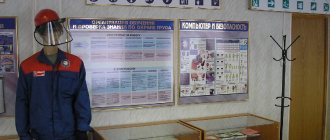Instructions in an organization or institution should be developed:
- for workers of certain professions and positions (teachers, educators, laboratory assistants, mechanics, etc.);
- for certain types of work (when conducting classes in classrooms, gyms, workshops, using technical teaching aids, during repair work, etc.).
The development of instructions on labor protection is ensured by the head of the organization, institution after preliminary consultations with the elected trade union body or representative body of workers, the labor protection service, the labor protection specialist (if any), and, if necessary, with other services and officials, in including SES, Rostechnadzor, Gospozhnadzor, etc.
Development of occupational safety instructions: should an occupational safety specialist do this?
The question is often asked in class: Which employee of the organization can the employer entrust with developing instructions? Should an occupational safety specialist do this?
According to Part 2 of Art. 212 of the Labor Code of the Russian Federation, the employer must ensure the development and approval of labor protection instructions. But no recommendations are given regarding who exactly the employer should assign this job function to. Many people believe that this should be the responsibility of an occupational safety specialist.
However, in accordance with the Professional Standard “Specialist in the field of labor protection”, approved by Order of the Ministry of Labor of Russia dated 08/04/2014 No. 524n, the labor function of such a specialist, in particular, includes:
- interaction with representative bodies of workers on issues of labor conditions and safety and coordination of local documentation on labor safety issues;
- revision of local regulations on labor protection issues in the event of new ones entering into force or amendments to existing acts containing labor law standards;
- providing methodological assistance to heads of structural divisions in the development of training programs for workers in safe labor methods and techniques, and instructions on labor protection.
If we are guided by this Professional Standard, the development of labor protection instructions for positions and types of work should be entrusted to the heads of departments (divisions), since they are the ones who have complete information about the labor functions of their subordinates, and the labor protection inspector provides assistance in such development. You can also connect the legal department and human resources department to it. In addition, as a rule, official approval of the already developed draft instructions is carried out with the labor safety inspector.
Legislative regulation
The employer must organize a healthy environment at his enterprise that contributes to maintaining the efficiency of personnel (Labor Code of the Russian Federation, Article 212). Ensure the creation of a clearly functioning labor protection system, develop and approve effective directives for workers (Federal Law of the Russian Federation No. 421).
Labor Code of the Russian Federation Article 212. The employer’s duty is to respect the human right to safe work
The procedure for the development and approval of labor protection instructions, their execution, recording and storage are carried out on the basis of:
- Occupation safety standards system;
- set of standards “Unified System of Technological Documentation” (USTD);
- industry and inter-industry standards and standard directives, which are drawn up on the basis of “Methodological recommendations for the development of regulatory requirements for occupational safety and health” (Resolution of the Ministry of Labor of the Russian Federation No. 80 of December 17, 2002);
- technical documentation of the enterprise, manufacturer of equipment used in carrying out work, taking into account current production conditions.
What does the labor safety instruction include?
Each instruction must be assigned a name and its registration number. The name should briefly indicate what profession, position or type of work it is intended for.
The instructions are drawn up, as a rule, in triplicate and are issued against signature to the performer and his immediate supervisor. The original instructions are kept by the head of the organization or institution.
Instructions should not include requirements that contradict laws and other regulations in force in the education system.
The development of labor protection instructions for workers in certain professions, positions and for certain types of work should contain 5 sections:
1. General labor protection requirements
2. Labor protection requirements before starting work
3. Labor protection requirements during work
4. Occupational safety requirements in emergency situations
5. Labor protection requirements upon completion of work
What is the validity period for such instructions?
What is the validity period of labor safety instructions? The answer to this question can be found in the same regulatory documents. In accordance with existing legislation, this period is five years. It also provides for an extension of the validity period of labor protection instructions in the event that working conditions have not been subject to serious changes. Early revision of such documentation is carried out under the following circumstances:
- According to the requirements of government agencies.
- As part of the use of new materials, technologies, equipment and equipment.
- In the course of making changes to the work process and working conditions.
- Based on information received, investigate accidents or incidents.
In the section “General labor protection requirements” it is recommended to reflect:
- conditions for the admission of persons to independent work in their profession or performance of relevant work (age, gender, health status, medical examinations, instructions, etc.);
- instructions on the need to comply with internal labor regulations;
- workplace safety requirements;
- requirements for compliance with work and rest schedules;
- characteristics of dangerous and harmful production factors affecting the employee;
- provision of special clothing, safety footwear and other personal protective equipment for this profession;
- fire safety requirements;
- the procedure for notifying the administration about cases of injury to workers and malfunction of equipment, devices and tools;
- instructions for providing first (pre-medical) aid;
- personal hygiene rules mandatory for workers when performing work;
- employee liability for violation of instructions.
In the “General Provisions” section, it is especially necessary to pay attention to the characteristics of dangerous and harmful production factors affecting the worker and to informing workers about the provision of personal protective equipment to them.
How are they accounted for and stored?
Each head of a department must be provided with a set of these documents, to the extent that it concerns his subordinates. This document is issued to the employees themselves against signature during personal instruction for the purpose of study, or it is posted at the workplace or in another, no less accessible one.
Such instructions are taken into account in journals of a certain form for accounting and issuance. Accounting books, according to the rules, are numbered, laced, signed by responsible persons and certified with a seal.
In the section “Occupational safety requirements during work” it is recommended to provide:
- methods and techniques for performing work safely, rules for using technological equipment, devices and tools;
- requirements for safe handling of starting materials (raw materials, blanks, semi-finished products);
- rules for the safe operation of vehicles, containers and lifting mechanisms;
- instructions for maintaining a safe workplace;
- main types of deviations from the standard technological regime and methods for their elimination;
- actions aimed at preventing emergency situations;
- requirements for the use of protective equipment for workers.
In the section “Occupational safety requirements upon completion of work” it is recommended to reflect:
- procedure for safe shutdown, shutdown, disassembly, cleaning and lubrication of equipment, devices, machines, mechanisms and equipment,
- procedure for handing over a workplace;
- requirement of personal hygiene;
- procedure for notifying the manager of all deficiencies discovered during work
The text of the instructions should be concise, clear and not subject to different interpretations.
The terms used in the instructions must correspond to the terminology adopted in the relevant legislative acts, GOSTs, technical regulations, and other documents on labor protection.
The revision of instructions for employees is organized by the employer (head of the institution, organization)
The instructions must be reviewed at least once every 5 years.
Procedure for verification and revision
At enterprises, instructions for protecting the activities of workers, as a rule, are reviewed no less than once every 5 years. The employer, by order, can extend the period of validity of such regulations for another period of the same period due to the lack of changes in the protection of the work performed and their conditions.
Thus, instructions developed to ensure safe conditions for workers to carry out activities are necessary documents for each enterprise.
Periodic inspections are carried out by the labor inspectorate to determine the availability of all instructions in the organization. These documents are used to investigate accidents involving workers. Therefore, in order to avoid unpleasant consequences, the company should not lack work instruction.
Additional information on this issue is presented in the video.
Instructions may be revised ahead of schedule:
- when revising intersectoral and sectoral rules and standard instructions on labor protection;
- when the working conditions of employees change;
- when introducing new technology;
- based on the results of the analysis of materials from the investigation of accidents, industrial accidents and occupational diseases;
- at the request of representatives of labor authorities of constituent entities of the Russian Federation or the federal labor inspectorate.
If during the period of validity of the instruction the working conditions of the employee have not changed, then by order (instruction) on the organization, establishment and decision of the trade union committee, the validity of the instruction is extended for the next period, about which an entry is made on the first page of the instruction (the “Revised” stamp is placed, date and signature person responsible for revising the instructions).
Approved instructions of an organization or institution are registered in the journal of instructions for the organization or institution in accordance with the procedure established by the Ministry of Labor of Russia.
The head of an organization or institution must constantly keep a set of current instructions, as well as a list of these instructions approved by him.
One set of instructions may be provided by a trade union committee of an organization, an institution or a representative body of workers, a labor protection commissioner, or a labor protection committee (commission).
All employees, heads of offices, workshops and other departments must be provided with instructions.
The location of instructions for employees, a list of them and a log of the issuance of instructions is determined by the head of the organization or institution, taking into account the availability of ease of familiarization with them.
Instructions can be handed out to employees or posted at their workplaces, taking into account the need to ensure simplicity and ease of familiarization with them.
If the information was useful, leave comments and share the link to this article on your social networks. Thank you!
Approval and storage
When answering the question of who approves the instructions for ensuring labor safety, it is impossible to give a specific answer. This could be any authorized service or department, for example, a trade union, a company's legal department, and so on. However, the presence of the signature and stamp of such an authorized person is required in the same way as the signature with the seal of the management of the organization as a whole. A mark indicating approval of the instructions is placed in the upper corner of the document. The date, seals and signatures of authorized persons are required.
Note! When approving the instructions, an order from the employer must be issued with the date the document comes into force.
The original instructions are kept by the person responsible for labor protection. Also, the fact of drawing up the standard is recorded in the enterprise journal. In this case, it is necessary to have copies of the document, which are sent to the divisions of the organization and are also subject to registration. In addition, employees must have free access to the text of the instruction; therefore, copies are needed at the appropriate workplaces and special boards.
Employees must have free access to instructions








